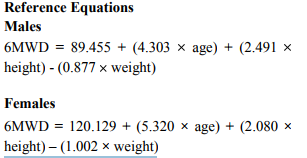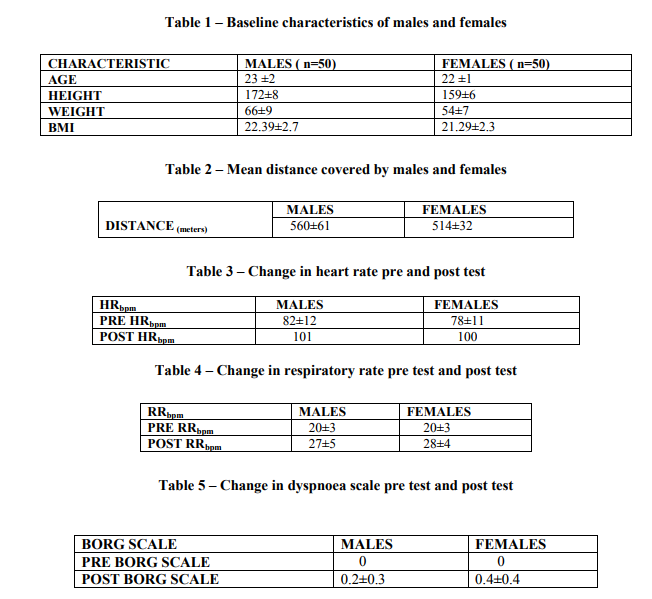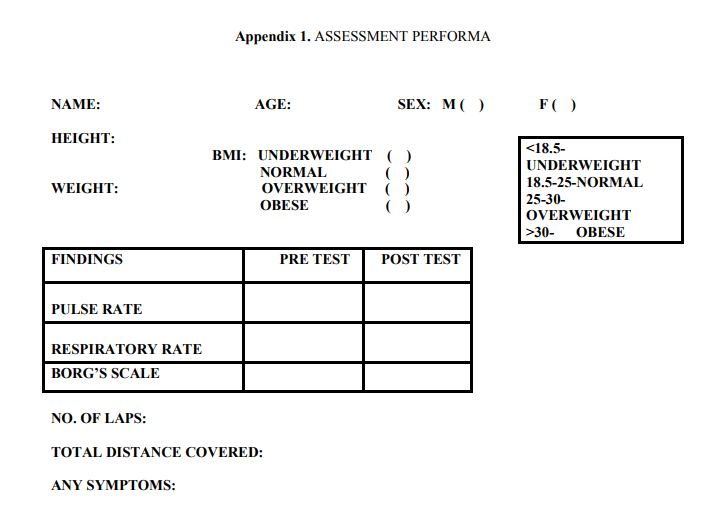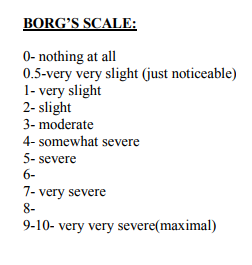IJCRR - 3(7), July, 2011
Pages: 78-83
Print Article
Download XML Download PDF
SIX MINUTE WALK DISTANCE IN HEALTHY ADULTS AGED BETWEEN 20-30 YEARS
Author: Prem.V, R.D. Chakravarty, Karvannan H., Rimmi, Vinita Arya, Manikankanna
Category: Healthcare
Abstract:OBJECTIVE: To find the normal range of distance covered during six minute walk distance (6MWD) in healthy adults aged between 20-30 years.
METHODS & RESULTS: Six minute walk distance was performed in a 100 feet hallway by 50 males and 50 females healthy adults ranging in age from 20-30 years. Each subject underwent a thorough physical examination including weight, standing height and BMI. Any subject with underlying cardiopulmonary, neurological or musculoskeletal pathology or conditions that could interfere with the walk test was excluded. All subjects underwent 6MWT and pre and post measurements such as distance, heart rate were recorded. Males walked 45 m more than females. Height of females is significantly correlated with 6MWD. There was significant increase in heart rate and respiratory rate following six minute walk test. CONCLUSION: Six minute walk distance covered in healthy individuals of 20-30 years is 560\?61 in males and 514\?32 in females.
Keywords: Six minute walk distance, Heart rate, Healthy adults .
Full Text:
INTRODUCTION
An individual‘s response to exercise is an important clinical assessment tool, since it provides a composite assessment of their respiratory, cardiac and metabolic system. The current goal standard for assessing a person‘s aerobic response is the maximum incremental cardiopulmonary exercise test. However, most daily activities are performed at submaximal levels of exertion and therefore it has been proposed that submaximal functional tests are better reflection of physical capabilities. The ability to work a set distance is a quick, safe, easy and inexpensive way to assess physical function. It is an important component of quality of life, since it reflects the capacity to undertake day to day activities. According to the American Thoracic Society (ATS), the most precise indication for the performance of the six minute walk test (6MWT) is mild or moderate lung or heart disease, in which it is used in order to measure treatment response, as well as to predict morbidity and mortality. Balke developed a simple test for examining functional capacity, measuring the distance walked during a definite period of time. A twelve minute performance test was then developed to evaluate the physical fitness of healthy individuals. This test was subsequently modified for use in patients with chronic bronchitis. In order to allow the test to be used in patients with respiratory diseases, for whom twelve minute walking was too demanding, a shortened version six minute walk test was developed and found to perform equally as well.1-3 Twelve minute walk test (12MWT) is a practical guide to everyday disability nevertheless it is both time consuming for investigator and exhausting for patients, therefore the possibility of using walking test of shorter duration to assess exercise tolerance was explored.4 Compared to traditional laboratory index of exercise capacity such as cycle, treadmill and step ergo meter; walk test require less technical expertise and equipment making them inexpensive and easy to administer. More importantly, they employ an activity that individuals perform on a daily basis that is walking. 6MWT has been frequently used to measure outcomes before and after treatment, in patients with moderate to severe heart and lung diseases and in their prognosis. It has also been used to measure functional status and for epidemiological research purposes. The distance covered in 6MWD has been showed to accurately predict morbidity and mortality from cardiopulmonary diseases. In healthy elderly subjects, 6MWT represents submaximal exercise, but at almost 80% of the VO2 max. A recent review of functional walking test concluded that 6MWT is easier to carry out, more acceptable and provides a better reflection of activities of daily living than other walk test.5 The normal six minute walk distance has been reported in western countries 1, 5-7 , but there is no normative data for Indian population. Hence the present study aims to generate a normative data for Indian population.
METHODOLOGY
Subjects
The study was carried out at Kasturba Medical College, Mangalore. There were 100 healthy volunteered subjects comprising 50 males and 50 females aged 20-30 years. Each subject underwent a thorough physical examination including weight, standing height and BMI( Appendix I). Any subject with underlying cardiopulmonary, neurological or musculoskeletal pathology or conditions that could interfere with the walk test was excluded. All subjects underwent 6MWT and pre and post measurements such as distance, heart rate were recorded. The healthy adults included were age group between 20-30 years and adults excluded were, Underlying cardiopulmonary, neurological, musculoskeletal pathology, Smoker for more than one year, Alcoholic for more than one year (occasional alcoholic can be included), Cognitively impaired subject, Uncooperative subjects.
PROCEDURE
Baseline measurements such as pulse rate, respiratory rate and dyspnoea level using Modified Borg 0-10 scale were taken. The materials required were 100 Ft. hallway, Sphygmomanometer, Stethoscope, Timer, Watch, Pen and relevant paper work, Cones, Chair, Inch tape. We instructed the subject that objective of this test is to walk as far as possible for six minutes and were told to ?walk back and forth in this hallway as quickly as you can so that you cover as much ground as possible?. They were informed that they could slow down or rest if necessary. We demonstrated way of walking and turning around the cones placed at the two ends of the hallway. They were also instructed not to run and jog. We positioned the subject at the starting line. As soon as subject started walking, timer was started. At the end of each minute subject were given feedback on the elapsed time and standardized encouragement in the form of statements such as ?you are doing well, keep up the good work? and ?do your best?. Test was terminated at the end of six minutes.1
Post test measurement
Heart rate was recorded using three finger palpation method at rest and at the end of test. Respiratory rate was recorded by observation method prior to and upon completion of 6MWT. At the end of the test distance was measured and dyspnoea was rated using modified Borg 0-10 scale.
DATA ANALYSIS
Test used for the study is student unpaired t-test. Result has been analyzed by SPSS.vers.14.0
RESULTS
The baseline characteristics of males and females are demonstrated in table 1.Mean distance covered in males is 45m greater than females table 2.There was a significant increase between pre test and post test heart rate table 3. There was a significant increase between pre test and post test respiratory rate table 4. There was no difference in pre test and post test Borg Scale table 5.
DISCUSSION
The present study showed considerable variability in the 6MWD of the healthy subjects aged 20-30 years; ranging 455 to 600m.On average the 6MWD was 560±61m in males and 514±32m in females. An important part of the variability is 6MWD was explained by height, sex, age and weight as independent variables. Distance walked in males and females is directly proportional to height and age and it is significant in females. Study done by T.Troosters et al. showed considerable variability in 6MWD of healthy subjects aged 50-85years,ranging 383-820m on an average 6MWD was 631±93m and it was 84m greater in males as compared to female subjects. An important part of the variability in 6MWD was explained by height, sex, age and weight as independent variable.8 The greatest 6MWD from among several repetition in a wide age range of healthy volunteers showed that the distance walked after the first walk was the best and in 86% individuals an average increase of 43m was observed from first to best 6MWD.Best 6MWD average 698±96m and was inversely related to age, directly to height and greater in male then female.9 The present study shows the correlation between height of the subject and the distance walked which is directly proportional to each other. Because taller individuals have greater stride length and so the distance covered is more. When compared between males and females, males cover longer distance because of greater functional capacity and more muscle mass. Moreover, distance walked is also directly proportional to age of the subject because the present study covers young population in a narrow range. In this age group as the as the age increases muscle mass increases. Study done in Chinese population shows marked similarity with the independent variables – height and sex. Height is another important determinant of 6MWD. This is not surprising as taller people have, in theory, a larger stride length and, thus, greater 6MWD.Young males are also found to have greater exercise capacity and 6MWD than young females, probably as a result of their greater muscle mass.10 In the present study, subjects were able to reach 50% HRmax which was 101 for males and 100 for females. The less distance walked during 6MWD could be due to different persons administering the test and variability in understanding the instructions by the subjects. Though there is not much difference in mean height of the subjects as compared to study done by Bernadine Camarri et al., the lesser distance walked by subjects may be because of lower HRmax as compared to 80% of HRmax in their study.11 The functional status and capacity can be effectively measured by functional walk test, the best being 6MWT.The measurement properties of the 6MWT have been the most extensively researched and established. In addition 6MWT is easy to administer, better tolerated and more reflective of activities of daily living than the other walk tests. Therefore the 6MWT is currently the test of choice when using a functional walk test for clinical or research purposes.

Limitations of the Study
There are certain limitations to present study. only 100 subjects were recruited, the sample size was inadequate for establishment of more accurate value of distance walked in Indian population.
Future Studies
Future studies need to be done with larger sample size with more trials. Studies are also needed for varying age groups for eg.30-70 years.
CONCLUSION
Six minute walk distance covered in healthy individuals of 20-30 years is 560±61 in males and 514±32 in females.



References:
1. ATS Statement Guidelines for Six Minute Walk Test American Journal of Respiratory and Critical Care Medicine vol 166, pp 111- 117 .
2 Sherra Solway, Lina Brooks, Yves Lacasse, Scott Thomas A Qualitative Systematic Overview Of The Measurement Properties Of Functional Walk Test used in the Cardiorespiratory Domain chest 2001;119:256-270
3. Kervio, Gaelle, Carre, Francois,Ville, Nathlie Reliability and Intensity of the 6MWT in healthy Elderly subjects Med. Sci. Sports Exerc, vol 35, no 1,pp. 169-174,2003
4. CR Mcgavin, S P Gupta 12 Minute walking test for assessing disability in chronic bronchitis. British Medical Journal 1976,1,822-823
5. Two, Six, Twelve min walking test in respiratory diseases British Medical Journal,vol284,29 may 1982
6. Fryderyk Prochaczek, Hanna Winiarska1 et al. Six-minute walk test on a special treadmill: Primary results healthy volunteers. Cardiology Journal 2007, Vol. 14, No. 5, pp. 447–452.
7. Paul L. Enright and Duane L. Sherrill Reference Equations for The Six Minute walk in Healthy Adults. AMJ Respir J 1999;14:270-274
8. T.Troosters, R.Gooselink, M.Decramer Six Minute Walking Test in healthy elderly subjects. Eur Respir J 1999;14:270-274
9. Gibbons, William J, Fruchter, Nadine, Sloan, Sherry et al Reference Values for a multiple repetition Six Minute Walk Test in healthy adults older than 20 years. Journal of Cardiorespiratory Rehabilitation 21(2):87-93 March/April 2001.
10. A.M. Li, J.Yin, C.C.W.Yu, T.Tsang, H.K.So, E.Wong et al The 6 MWT in healthy children; reliability and validity Eur Respir J 2005;25:1057-1060
11. Bernadine Camarri, Peter R. Eastwood, Nola M.Cecins, Philip J. Thompson, Sue Jenkins Six minute walk distance in healthy subjects aged 55-75 years. Respiratory Medicine (2006)100,658-665
|






 This work is licensed under a Creative Commons Attribution-NonCommercial 4.0 International License
This work is licensed under a Creative Commons Attribution-NonCommercial 4.0 International License